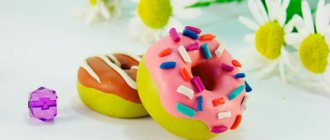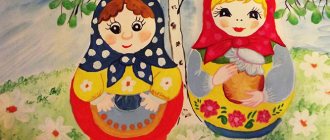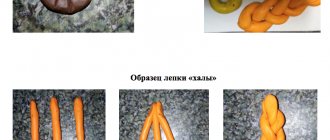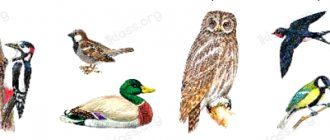Modeling construct “Beautiful Birds” for the older group (5-6 years old)
Construct of joint educational activities
according to PM 02 Organization of various types of activities and communication of preschool children
Elizaveta Artemovna Novikova, specialty 02/44/01 Preschool education of student group 33 “A” group
Date of:
06.10.2020
DOW:
MDOU No. 9
Group:
senior group (5-6 years old)
Educator:
Shmidt Marina Aleksandrovna, Voinkova Irina Valerievna
Head of practice:
Ibragimova Daria Andreevna
Methodist:
Chemezova Natalya Yurievna Assessment_______________
Type of OD:
productive activity (sculpting)
Subject:
"Beautiful Birds"
Educational area:
artistic and aesthetic development, social and communicative development, cognitive development.
Shapes:
frontal, group
Planned result:
children are neat and finish things;
children willingly join in joint activities
children are proactive in conversation, answer questions, ask counter questions
children know how to sculpt decorative toys;
children have ideas about the color and shape of the depicted object;
Target:
To form an interest and aesthetic attitude towards objects of folk arts and crafts.
| OBJECTIVES of the educational program | Tasks taking into account the individual characteristics of group students |
| Educational tasks: Strengthen your neat sculpting skills. Strengthen the ability to thoroughly wash your hands after finishing modeling. Developmental tasks: Develop children's aesthetic perception. Training tasks: figurative: Teach children to portray a Dymkovo turkey toy. technical: Continue to develop technical skills and skills in working with plasticine: rolling, flattening. color: Continue working with plasticine of the same color. compositional: Continue to develop the ability to sculpt small details when working with a stack. | Carry out a systematic individual approach. |
Principles of preschool education (FSES DO):
· building educational activities based on the individual characteristics of each child, in which the child himself becomes active in choosing the content of his education, becomes a subject of education (hereinafter referred to as individualization of preschool education);
· assistance and cooperation of children and adults, recognition of the child as a full participant (subject) of educational relations;
· supporting children's initiative in various activities;
· formation of cognitive interests and cognitive actions of the child in various types of activities;
· age adequacy of preschool education (compliance of conditions, requirements, methods with age and developmental characteristics.
Summary of a modeling lesson in the preparatory group “Dymkovo Cockerel” 04/23/2020.
Summary of a modeling lesson in the preparatory group “Dymkovo Cockerel” 04/23/2020.
Target:
teach children to convey the image of the Dymkovo rooster in sculpting: an oval body, a curved tail with wavy edges.
Practice sculpting the basic shape from a whole piece using previously learned sculpting techniques. Develop aesthetic perception. Materials.
Plasticine, stacks, modeling boards, Dymkovo clay toys.
Progress of the lesson:
– Dear guys, since our theme of the week is “I am a citizen of Russia,” I invite you today to go on an interesting journey into the world of art and the world of folk crafts. "Dymkovo toy"
Painted clay toys were made in the settlement of Vyatka for a very long time. They were sold at spring auctions and fairs, where people flocked to the festive festivities - “whistling”. What kind of clay whistles did the craftswomen sculpt for this day! What are these toys called? That's right, Dymkovo. This is a young lady and an accordion player, a turkey, a cockerel and a horse. What material do craftsmen make toys from? That's right, made of clay. So, what kind of toys? That's right, clay. What elements of painting do you see on toys? Straight and wavy lines, dots, rings, circles, ovals, diamonds. What colors did the artists use to paint the Dymkovo toy? Blue, red, yellow, green, crimson colors. Also black and gold. All colors are bright, elegant, festive.
The patterns in Dymkovo toys are not random, but traditional.
“Many, many years ago, craftswomen began to paint their toys in circles, straight and wavy lines. Everyone liked these patterns and loved them. These craftswomen taught other craftswomen - their daughters and granddaughters, and those their daughters. And today, craftswomen in the village of Dymkovo continue to paint toys the way their grandmothers and great-grandmothers did.” – Creating a Dymkovo toy is a labor-intensive manual production. It’s not for nothing that among folk craftswomen there is this story about the birth of the Dymkovo toy: “Before the toy becomes like this, a lot of work needs to be put in. After all, a toy must be born 3 times.
The first time it is born is when it is sculpted. It is brown and brittle. The second time she is born is when she is burned to make her stronger. The third time is born when she is painted.
Our cockerel is loud. In the morning he shouts hello. He has boots on his feet, and earrings on his ears. There is a comb on the head. This is what our cockerel is like.
Today we will sculpt a Dymkovo cockerel.
Let's look at the cockerel: it has an oval body, wavy wings, fluffed up importantly, and a fan-shaped comb. A long beard that looks like a bunch of berries. Lush “wavy edges of the tail”, thick legs.
Summary of the lesson in the senior group “Sculpting a bird based on the Dymkovo toy.”
Summary of the lesson in the senior group “Sculpting a bird based on the Dymkovo toy.”
Educator: Baykhonova E.A.
Program content:
• Continue to introduce children to Dymkovo toys
.
• To cultivate an aesthetic attitude towards the products of folk craftsmen and respect for their work.
• Continue to teach children to sculpt the details of the overall figure from separate pieces of clay, and then smoothly connect them using daubing (stacks)
.
• Practice rolling, flattening, and pulling techniques when performing individual elements.
• Develop fine motor skills of the hand.
• Learn to draw patterns on the bird in a stack.
Material: Clay toys
, illustrations with
Dymkovo toys
, boards according to the number of children, water bowls, rags for hands, clay, stacks, tape recorder. Music: Russian folk, classical by D. Shostakovich.
Progress of the lesson
Calm Russian folk music sounds. - Hello guys! Do you want to know what I'm rich in today? Just smile at the guests first, bow, and quickly turn to me. – I made toys
Yes, I invited you here.
I want to ask you a riddle: And these toys are not simple
, but magically painted: snow-white, like birch trees, circles, squares, stripes - the pattern would seem simple, but you can’t look away!
-What toys is the riddle about
?
( Dymkovsky )
.
The teacher invites the children to “ Dymkovo village ”
Breathing exercises.
- What a whiff of smoke
!
(children inhale deeply through their noses)
.
– Do you smell smoke? - Look who's meeting us? (young ladies, horses, etc.)
Game:
“Zarya Zaryanitsa” (the teacher and children are in the Dymkovo village )
- Why are
the toys
you see called
Dymkovo
?
— What material are they made of? — What did Dymkovo masters
?
— Why did they love to sculpt animals and people? — What mood do such toys
?
— What paints do Dymkovo masters
?
— What elements of Dymkovo painting do you know
?
-Come on, guys, we’ll dream... Sit on the carpet, close your eyes, listen to my voice and music (relaxation)
— We brought clay from a distant hillock. Well, let's get to work, miracle masters! I'll make a horse, I'll pet it. And I’ll attach a saddle with fringe on the back. Let's mold, dry - and into the oven! And then we'll write it down. We will bake toys
, the stove is glowing with heat.
And in the oven there are not rolls, but in the oven there are Easter cakes, Not crumpets, not cheesecakes, but in the oven there are toys
!
- Now, guys, sit down at the tables.
Someone skillfully made holes in the back of the bird. And the tit suddenly began to sing with the voice of spring itself. These birds are vocal and elegant like calico! Whoops, whew, whew, whew! Whoops, whoops, I see the nest! (riddle-poem about a bird)
— What parts does a bird consist of? (head, body, tail, wings)
.
– How will we divide the clay to sculpt the bird? - What shape does the head have? (ball)
.
- What shape does the body have? (ovoid)
.
— How are we going to sculpt the wings? (flatten)
.
— How are we going to sculpt the beak and tail? (pull out)
.
- What will we use to connect the head and body? (using stacks)
. — We draw the plumage of the bird in a stack.
The teacher reminds children of the rules for working with clay:
- What if your hands get dry? (wet with water)
.
— What if the clay cracks? (wipe with water, drainage, a wet cloth)
.
- If your hands are dirty? (wipe with a cloth)
.
To prepare our hands for work, let's play with our fingers.
Finger game “Ten birds - a flock ”
(Clench your fists and bend one finger to the name of each
bird
)
Sing along, sing along, Ten birds - a flock
: This
bird is a nightingale
, This
bird is a sparrow
, This
bird is an owl
.
Sleepy little head: This bird is a waxwing
, This
bird is a corncrake
.
This bird
is a gray feather bird.
This is a finch, This is a swift, This is a cheerful siskin... Well. And this is an evil eagle. Birds
,
birds go home
!
(The game is played 2 times at different paces)
.
Children do their work to the music.
Phys. Minute "Rooster"
A rooster walked along the shore. Steps with high lifting of legs and arms. I slipped and fell into the river! Move your arms in a circular motion, squat down. The rooster will know that from now on he will rise and shake his finger. You have to watch your step. Bend forward.
Final part
What did we do today? What folk painting did you and I use?
Summarizing.
3








